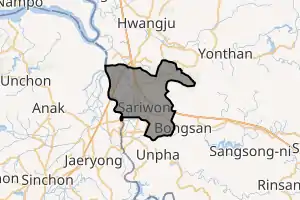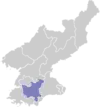Sariwon
Sariwŏn (Korean pronunciation: [sa.ɾi.wʌn]) is the capital of North Hwanghae Province, North Korea.
Sariwŏn
사리원시 | |
|---|---|
| Korean transcription(s) | |
| • Chosŏn'gŭl | 사리원시 |
| • Hancha | 沙里院市 |
| • McCune-Reischauer | Sariwŏn-si |
| • Revised Romanization | Sariwon-si |
.jpg.webp) View of Sariwon | |
 Map of North Hwanghae showing the location of Sariwon | |

| |
 Sariwŏn Location within North Korea | |
| Coordinates: 38.50778°N 125.75444°E | |
| Country | |
| Province | North Hwanghae Province |
| Population (2008) | |
| • Total | 307,764 |
| • Dialect | Hwanghae |
| Time zone | UTC+9 (Pyongyang Time) |
Population
The city's population as of 2008 is 307,764.
Administrative divisions
Sariwŏn is divided into 31 tong (neighbourhoods) and 9 ri (villages):
|
|
Healthcare
Sariwŏn has the only pediatric hospital (founded by Hungarians in the 1950s) in the entire region; it serves 16 districts and 500,000 children and teens annually.
Industry
Sariwŏn has a Potassic/Potash Fertilizer Complex and a tractor factory.
Education
Educational institutions include the University of Agriculture, University of Geology, University of Medicine, University of Education nos. 1 & 2 and the Sariwŏn Pharmaceutical College of Koryŏ.
Tourism
The "Sariwŏn Folklore street" was constructed during Kim-Jong-il's rule. Built to display an ideal picture of ancient Korea, it includes buildings in the "historical style" and a collection of ancient Korean cannons. Although it is considered an inaccurate romanticized recreation of an ancient Korean street, it is frequently used as a destination for foreigners on official government tours. Many older style Korean buildings exist in the city.
Transport
Sariwŏn is served by Sariwŏn Ch'ŏngnyŏn and several other stations on both the P'yŏngbu and Hwanghae Ch'ŏngnyŏn lines of the Korean State Railway.
Sariwŏn has a trolleybus system with two Ikarus 280T articulated trolleybuses; they are converted from diesel Ikarus 280 buses due to the lack of roof equipment. Regular trolleybuses were mothballed at the depot from 2020. The service is supplemented by regular buses.[1]
Climate
Sariwŏn has a humid continental climate (Köppen climate classification: Dwa).
| Climate data for Sariwŏn (1981–2010) | |||||||||||||
|---|---|---|---|---|---|---|---|---|---|---|---|---|---|
| Month | Jan | Feb | Mar | Apr | May | Jun | Jul | Aug | Sep | Oct | Nov | Dec | Year |
| Average high °C (°F) | −0.7 (30.7) |
2.9 (37.2) |
9.2 (48.6) |
17.5 (63.5) |
22.9 (73.2) |
27.0 (80.6) |
28.5 (83.3) |
29.3 (84.7) |
25.5 (77.9) |
19.2 (66.6) |
9.9 (49.8) |
2.6 (36.7) |
16.2 (61.2) |
| Daily mean °C (°F) | −5.4 (22.3) |
−2.2 (28.0) |
3.6 (38.5) |
11.0 (51.8) |
16.8 (62.2) |
21.5 (70.7) |
24.3 (75.7) |
24.6 (76.3) |
19.7 (67.5) |
12.9 (55.2) |
4.8 (40.6) |
−2.0 (28.4) |
10.8 (51.4) |
| Average low °C (°F) | −9.8 (14.4) |
−6.8 (19.8) |
−1.3 (29.7) |
5.3 (41.5) |
11.5 (52.7) |
17.0 (62.6) |
20.8 (69.4) |
20.8 (69.4) |
14.9 (58.8) |
7.6 (45.7) |
0.4 (32.7) |
−5.8 (21.6) |
6.2 (43.2) |
| Average precipitation mm (inches) | 12.4 (0.49) |
12.2 (0.48) |
22.0 (0.87) |
43.4 (1.71) |
77.9 (3.07) |
74.8 (2.94) |
208.4 (8.20) |
198.5 (7.81) |
101.4 (3.99) |
39.8 (1.57) |
35.2 (1.39) |
15.2 (0.60) |
841.2 (33.12) |
| Average precipitation days (≥ 0.1 mm) | 4.7 | 3.5 | 4.3 | 5.8 | 7.4 | 7.7 | 12.3 | 10.2 | 6.6 | 5.1 | 6.6 | 5.6 | 79.8 |
| Average snowy days | 6.0 | 3.9 | 1.9 | 0.2 | 0.0 | 0.0 | 0.0 | 0.0 | 0.0 | 0.1 | 2.3 | 5.2 | 19.6 |
| Average relative humidity (%) | 71.8 | 68.2 | 65.1 | 62.1 | 66.9 | 73.7 | 83.2 | 82.6 | 76.7 | 72.3 | 72.5 | 71.9 | 72.3 |
| Source: Korea Meteorological Administration[2] | |||||||||||||
References
- "Sariwon". transphoto.org. Retrieved 2021-01-02.
- "30 years report of Meteorological Observations in North Korea" (in Korean). Korea Meteorological Administration. pp. 232–281. Archived from the original on 21 December 2020. Retrieved 25 December 2020.
- "No committee to develop ties with Lahore's twins". Daily Times of Pakistan. 2007-03-02. Archived from the original on 2013-09-29. Retrieved 2008-02-08.
- "Sister City Ties Established between DPRK and Mexico". KCNA. 21 April 2004. Archived from the original on 8 September 2017. Retrieved 3 December 2017.
Further reading
- Dormels, Rainer. North Korea's Cities: Industrial facilities, internal structures and typification. Jimoondang, 2014. ISBN 978-89-6297-167-5
External links
| Wikimedia Commons has media related to Sariwon. |
| Wikivoyage has a travel guide for Sariwon. |
- Information about the potassic/potash fertilizer complex
- Basic statistics about Sariwon
- News about Sariwon's pediatric hospital
- Photo of entrance to the city
- Photo of a street scene
- Photo of a street scene
- City profile of Sariwon
- Folk Street in Sariwon picture album at Naenara
